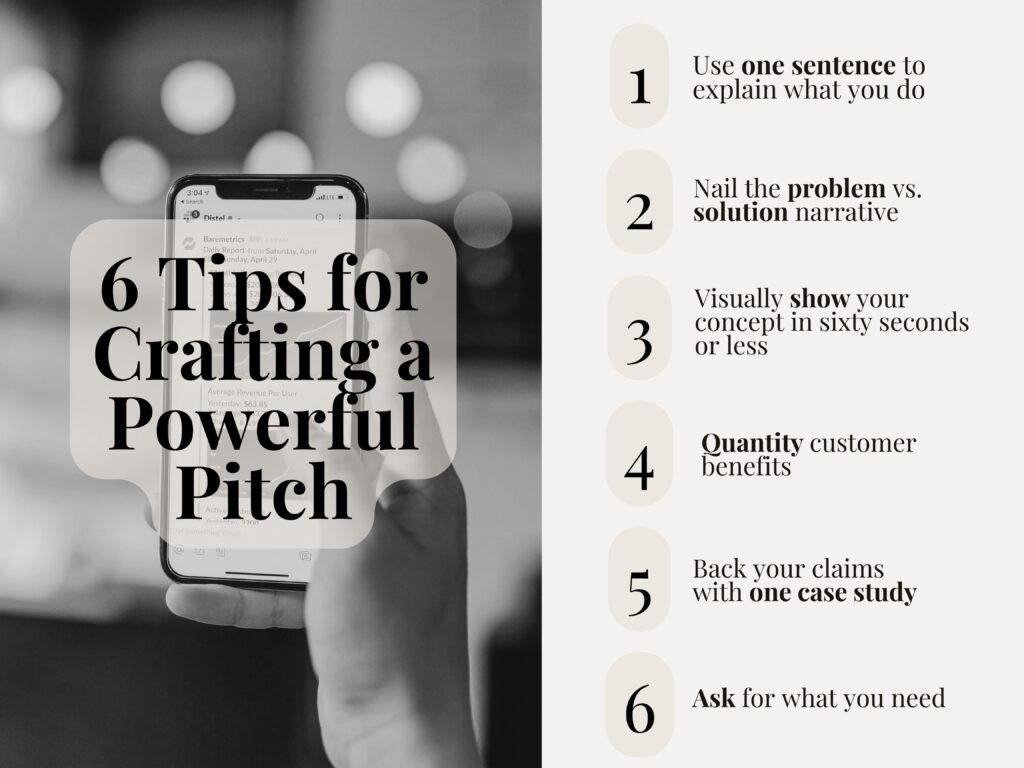Use Our Pitch Deck Template to Tell a Story That Wins Over Your Audience
ENTREPRENEUR HUB / 18 SEPTEMBER 2024

What is a Pitch Deck?
A pitch deck is a presentation that businesses use to introduce themselves to potential investors, clients or partnerships. The deck is usually in the form of a slide presentation that is shared with an audience in person, however, it can also be distributed digitally.
Its purpose can be twofold. First and foremost, it aims to articulate the essence of the business in a condensed and meaningful way. This includes an overview of their vision – the why, what they are offering to the market – the what and their strategy, objectives and future direction – the how. Secondly, a pitch also aims to persuade the audience to take some form of action – whether to invest, partner, advocate or any other type of engagement.
What Makes a Pitch Deck Effective?
A strong pitch deck using storytelling as a way to communicate the potential for success in an authentic, memorable and meaningful way. The most successful pitches are ones that have been carefully curated, they know exactly what to include but most importantly know what to exclude. The pitches that captivate an audience strike a balance between having relevant content whilst being aesthetically pleasing to the eye.
While the structure of a pitch deck is important, the effectiveness of your presentation comes down to several factors:
CLARITY
Can your audience easily understand your message? Promote inclusivity by keeping your language simple but professional. This might mean trying to limit the use of industry or business-specific jargon.
EMOTIONAL CONNECTION
Are you telling a story that resonates with your audience’s emotions? People invest in people as much as they do in ideas, so communicate in a way that feels authentic to you and your values. Try to bring some of your personality to the meeting, ask questions and keep a good level of eye contact with your audience.
DATA DRIVEN INSIGHTS
Are you backing up your claims with facts, figures, or data? Show your credibility with accurate market research, user feedback, or performance metrics. Make sure to cite these and use credible sources only.
A successful pitch deck balances inspiration with logic—it convinces through a mixture of emotion, reason, and vision.
How to structure a Pitch Document
Pitching can often feel like a balancing act, and there’s no one-size-fits-all formula. It’s a subjective process heavily influenced by the founder’s preferences, the nature of the business, and the audience being addressed. Some prefer detailed financial analysis, while others are more focused on vision and storytelling.
The key is to nail these two questions first:
1. Who am I pitching to?
What is their background? Do you know their values? What other collaborations interest them? Whats important to them? Not sure, ask!
2. What do I hope to achieve from pitching to them? Make sure that these objectives are clear, specific, measurable and realistic.
Do you need $1M in funding for the next quarter? Do you want them to introduce you to their network of buyers?
Once you are clear on those two points, you’ll know you’re ready to start your document. We’ve found success in using what we call the Nine-Slide Rule. This structure provides a simple, clear, and effective way to present your business, focusing on what matters most without overwhelming your audience with too much information.
Remember, once you have your initial pitch set up, you’ll have the foundation of a solid pitch deck ready to go to market. As you start to engage various audiences, you’ll be making continuous adjustments depending on the audience.
Our Pitch Deck Template Using the 9-slide rule
Let’s take a closer look at what each slide should accomplish
SLIDE 1 – INTRODUCTION
The first impression counts, so your opening slide needs to make a strong impact. Present your brand and value proposition concisely. Why does your business exist? Why does it matter? The introduction should give the audience an immediate sense of what you stand for and what you hope to achieve. It’s not just about stating facts; it’s about telling a story that resonates with the values and vision of your audience.
SLIDE 2 – THE PROBLEM
Every successful business is created to solve a problem. This presentation slide needs to clearly and convincingly articulate the problem. You should frame the problem in a way that highlights its urgency and demonstrates a real opportunity for growth or change. Use data, personal anecdotes, or relatable examples to help your audience see the problem from your perspective.
SLIDE 3 – THE SOLUTION
After you’ve identified the problem, present your solution as a logical, innovative, or unique answer. This slide should focus on your product or service, explaining what it is, how it works, and why it’s different from what’s already out there. Highlight your unique selling points (USPs) and core value. Be sure to tie the solution back to the problem in a way that feels natural and inevitable.
SLIDE 4 – THE BUSINESS MODE
Your audience, whether they are investors, potential clients, or partners, will want to understand how you plan to generate revenue and grow your business. You should outline your business model (B2B. B2C, D2C etc), revenue streams, pricing strategy, payback period, customer acquisition cost (CAC), and customer lifetime value (LTV). These KPI’S will demonstrate that you have done your homework, and your business model is sustainable and has growth potential.
SLIDE 5 – THE COMPETITION
Competition exists in every industry, and it’s crucial to demonstrate that you understand your market. A competitive matrix helps your audience comprehend how your business compares to others. Use a chart or table to compare key features, pricing, and value propositions. This slide should clearly communicate how you’re different and why those differences give you an edge.
SLIDE 6 – THE CASE STUDY
If you have already gained traction or validated your solution in the market, this is the place to use it. Use metrics, testimonials, press coverage, customer feedback, or case studies to bolster the credibility of your business. This slide is crucial for building trust with your audience and demonstrating that your idea works in real-life scenarios, as well as your ability to course-correct when expectations fall short of original plans.
SLIDE 7 – THE ROADMAP
Illustrate your vision by breaking down your roadmap into the past, present, and future. This will allow your audience to see not only where you have been and where you are, but also where you are headed. Highlight upcoming product launches, market expansions, or key strategic initiatives.
SLIDE 8 – THE FINANCIAL PROJECTION / MUTUAL BENEFITS
This slide should be adaptable based on the audience. For potential investors, include high-level financial forecasts covering revenue, operating costs, profit margins, and other key financial metrics. Be transparent about the assumptions and variables influencing these projections. Compared to industry standards, it adds credibility. For client or collaboration pitches, replace the Financial Projections slide with a Mutual Benefits slide. Emphasise the value your business brings and how the collaboration will be mutually beneficial, outlining specific benefits like cost savings, increased efficiency, improved product quality, access to new markets, or strategic advantages.
SLIDE 9 – THE ASK
The closing slide is where you outline exactly what you need from your audience. Whether it’s funding, a strategic partnership, or another form of support, be specific and direct. Clearly explain how their involvement will benefit both your business and them, and what you plan to do with the resources or partnership you’re asking for.
By following this structured approach, you will create a clear and compelling pitch that highlights the most critical aspects of your business while aligning with your audience’s expectations and interests. This framework can be adapted to suit various needs, whether it’s an investment pitch, a partnership proposal, or a client presentation while maintaining focus and impact.
6 Tips for Crafting a Powerful Pitch
Every pitch deck should tell a compelling story.
Here are six tips to keep in mind as you create your own:
- Always start your pitch by explaining what you do in one sentence. Get clear from the start, and use the rest of the presentation to break down the details. Failing to do this, might mean failing to captivate your audience.
- Nail the problem vs. solution narrative. Spend time explaining what the actual problem you are trying to solve, and then create a narrative as to how you are best placed to solve it
- Show you audience in sixty seconds or less in a visual concept, image, or video as to how your product, service, or idea works
- Highlight and quantify the benefits that you can deliver to your target customers. Get specific here. Numbers talk.
- Back your claims with one single case study only. You don’t need to include five case studies; if you’ve done your research on your audience, you’ll know which case study will resonate most with their values and interests.
- Remember to ask what you want from your audience. Whether it is funding, referrals, introductions, a mailing list, etc., make sure you leave enough time at the end of your presentation to ask for their support.

Finding Your Unique Voice
Crafting a pitch deck is about telling a story that reflects your business and invites your audience to be part of the journey. Focus on clarity, emotional connection, and data-driven insights to create a compelling narrative that informs and inspires action. Effective pitch decks engage the audience and align your objectives with their needs and interests.
Are you ready to share your story? Whether you’re looking for investment, partnership, or client collaboration, we can help you refine your pitch deck and tailor it for success. Submit your project by scheduling an introductory call here, or submit our new client application here.






Read the Comments +